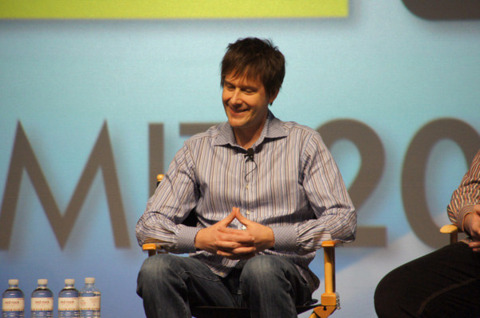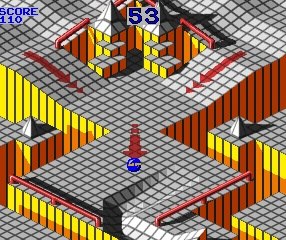Marble Madness played for keepsies
GDC 2011: Mark Cerny postmortem tracks evolution of Atari hit from minigolf game with a force feedback trackball to isometric arcade classic.
Who was there: Marble Madness creator Mark Cerny was on hand to deliver another installment in the 2011 Game Developers Conference series of classic game postmortems.
What they talked about: While Cerny's GDC to-do list for Wednesday called for the designer to host a career retrospective for influential Sega developer Yu Suzuki, his Thursday session allowed him to talk about his own work. Specifically, the session gave Cerny a chance to recount the development of his breakthrough hit arcade game Marble Madness.

Cerny began his talk recapping his own introduction to games, 1977's Space Invaders. He loved the Taito classic and nearly all arcade games because each new game during that era seemed to be its own unique genre. Wanting to get into the action himself, he and his brother set out to do a 3D, real-time, first-person shooter role-playing game that would use vector art and hidden-line wireframe graphics. Seeing as it was still 1977, the project was wildly ambitious and never got off the ground.
In 1982, after he had contributed to a number of books on arcade games (he was a skilled player in his own right), Cerny landed a job with Atari. While he was happy to be making games, it wasn't the fame and fortune he expected. Designers got no credit at the time, so the only way to get their names into games was to include their initials as a default entry on the game's high scores list. There wasn't much fortune to go around then either, as Atari received no cut of the coin-op take from its machines, no matter how well they did. Another frustration for Cerny was that the scope of games was fairly limited. A three-minute play session common to arcade games of the era was a far cry from the game he and his brother had envisioned.
However, there were benefits to the way the industry was set up. There was no marketing of any kind for arcade games, which Cerny said made for the most level playing field the gaming industry has ever seen. There was also a focus on every game including unique controls and gameplay. If a top-down fighting game was already on the market, Cerny said designers couldn't make another one because they would be seen as insufficiently original.
Two Atari titles Cerny was particularly taken with were Battlezone and I, Robot, both early attempts at 3D. The games were a bit rough-looking as a result, but they gave Cerny a goal. He wanted to create a 3D game with visuals that would be seen as "solid and clean." The first such title to hit the market meeting those criteria were Crystal Castles and Cerny's own Marble Madness.
Originally, Cerny looked at Marble Madness as a minigolf game with a touch-screen interface. People around the office hated the idea though, so he came up with the idea for a motorized trackball. The notion was that if the ball were rolling down a hill in the game, the trackball would automatically speed up in that direction, and players could tell the lay of the land better based on the way the trackball moved.
While the motorized trackball was prototyped, the hardware designers ran into problems. Where standard trackballs had three rollers around the ball to read input, the motorized version had four rollers, two to read motion and two to cause motion. Unfortunately, the designers couldn't get all four rollers to make good contact with the ball at the same time, so the result was a trackball insufficiently precise and durable for the arcade environment. Trackballs were already relatively expensive ($50 each) and regularly broke down as it was.
From the start, Cerny wanted there to be strong cooperative and competitive elements to the game in the form of a race across a dynamically changing playfield. Unfortunately, when Cerny put all the pieces together, it didn't work well. The player-chasing bump in particular was "just creepy," Cerny said. However, a colleague suggested he ditch the dynamically changing playfields, which allowed him to add basic ray tracing for shadows in the game. The change set development back a month, but Cerny said it gave the game its distinct look.
By the time the game's concept was fleshed out in June of 1984, it was far different than originally envisioned. It was a race against time instead of an AI marble. It was on a static playfield instead of a dynamically changing one, and it featured a standard trackball instead of a motorized one. But from that point on through the final six months of development, Cerny said it was more or less smooth sailing for the game.

The game shipped that December and sold 4,000 units. That was a far cry from the hundreds of thousands sold by Pac-Man, or even the tens of thousands moved by Battlezone and hits of earlier years. But given the ongoing crash of the gaming industry, that was enough to make it the best-performing game of the time.
One thing people ask Cerny about is why he made the game so short. The game can be finished in four minutes, which Cerny said was a big part of why its run atop the charts was brief (lasting just six weeks). However, that wasn't entirely bad, as Atari had more arcade games to sell when Marble Madness fell out of favor with operators.
An audience member asked how he would remake the game today, to which Cerny said he wanted to do a philosophical adventure game with a marble going out into the real world on a quest. While he spoke of the idea affectionately, he admitted it will never happen.
Quote: "It was necessary to kill the player so damn fast."--Cerny, on why the arcade game was tuned to be so difficult.
Takeaway: Much like the original game Cerny and his brother set out to make, Marble Madness as originally envisioned was too ambitious. However, Cerny adapted his game design around the limitations presented to him and wound up creating an arcade hit that could be cleared in four minutes but that has nonetheless endured for more than a quarter century.
Got a news tip or want to contact us directly? Email news@gamespot.com
Join the conversation